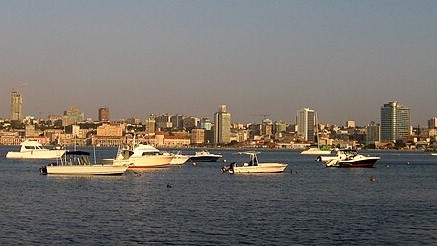By Helen Struewn
In Angola, cities rise and unfold with the cadence of a nation that has long balanced tradition with the inevitability of change. From the rhythmic pulse of the Atlantic coast to the tranquil highlands of the interior, each urban center carries a distinct story—etched in architecture, culture, and the everyday lives of its residents.
Luanda: The Capital’s Tide
Perched along the Atlantic, Luanda stretches like a ribbon between sea and cityscape, its skyline a mosaic of glass towers, colonial facades, and bustling streets. The Marginal de Luanda promenade curves gracefully along the waterfront, where cafés, restaurants, and public spaces hum with activity against the backdrop of fishing boats and cargo ships.
Above the city, the 16th-century Fortaleza de São Miguel stands guard, its weathered walls holding centuries of history. Inside, the Museu Nacional de Antropologia preserves artifacts of Angola’s diverse ethnic heritage, linking past and present. Music drifts into the night from bars and clubs, where semba rhythms mingle with modern beats, defining the capital’s cultural tempo.
Lubango: City in the Highlands
Southwest in the Huila Province, Lubango rests in a cradle of mountains. Morning mists soften the rugged escarpments, and at Tundavala Fissure, sheer cliffs give way to sweeping views that dissolve into the horizon. The city is crowned by its Christ the King statue, a sentinel in stone gazing out over the valley.
Markets brim with color and movement, offering produce, textiles, and handmade crafts. Here, the pace slows, yet the vibrancy of local festivals reminds visitors that Lubango’s heart beats in sync with Angola’s enduring traditions.
Benguela: By the Sea
Benguela’s shoreline unfurls in golden arcs, with Praia Morena as its crown jewel—a stretch of sand where fishing boats rest on the tide and the air carries the salt of the Atlantic. Colonial architecture lines the streets, whispering echoes of the city’s past as a Portuguese stronghold.
A short journey leads to Catumbela, where quiet beaches meet the historic Igreja de São Pedro. Benguela’s arts scene, alive with music and dance, comes to the fore during the annual Festival de Benguela, a celebration where tradition and performance merge.
Huambo: The Garden City
Set high in the central plateau, Huambo lives up to its moniker. Tree-lined avenues and parks give the city a softness rare in urban centers. The Huila Botanical Garden offers a curated glimpse of Angola’s flora, while the soaring Catedral de São João Batista stands as a testament to colonial-era craftsmanship.
Huambo’s festivals weave together music, food, and communal gatherings, offering insight into a community where history and hospitality remain intertwined.
Kuito: A Testament to Resilience
In Kuito, resilience is not merely a trait but a defining identity. Scarred by conflict yet rebuilt with determination, the city thrives in the heart of Angola’s central highlands. The Kuito Central Market bustles with trade, its aisles thick with the scent of spices and the chatter of merchants. From Bandeira Hill, the city and its rolling surroundings stretch outward, a view that captures both scars and growth.
Kuito’s cultural events honor survival and progress, reinforcing its role as a living emblem of Angola’s recovery.
A Nation in its Cities
Together, these cities form a living atlas of Angola—each distinct, yet bound by threads of shared history and forward momentum. From Luanda’s oceanfront energy to Lubango’s mountain air, from Benguela’s coastal charm to Huambo’s green expanses and Kuito’s enduring spirit, the urban landscapes reveal a country defined as much by its people as by its geography.
Sources
- Messiant, Christine. Angola: The Challenge of Statehood. James Currey, 2004.
- Pearce, Justin. Political Identity and Conflict in Central Angola, 1975–2002. Cambridge University Press, 2015.
- World Bank. Angola Urban Development Overview. 2023.
- Governo de Angola, Ministério da Cultura e Turismo. Guia Turístico Nacional, 2022.


